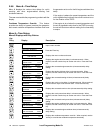TP-6200 10/12104 Section 2 Operation
Local Programming Mode On
2.8.10 Menu 10—Output Setup
Menu 10 provides setup of the user-defined system,
digital and analog status and fault outputs, and relay
driver outputs (RDO) 1--31. These outputs provide a
multitude of choices for configuring customized auxiliary
outputs. Additional individual outputs are available for
monitoring, diagnostic, and control functions.
The user must enable the programming mode to edit the
display.
Note: Some data require entry using a PC in the
Remote Programming mode. See the monitor
software operation manual for details.
Common Faults
The user can program a single fault comprised of status
and fault events from 3 common fault programs—
system, digital, and analog faults.
Up to 66 user-defined system events are available,
which provide status and fault information. See Group B
on the following pages for specific descriptions. The
NFPA-110 faults are part of the system fault program
and are comprised of 15 individual faults shown on this
page.
Up to 21 user-defined digital status and fault events
designated as D01 to D21 are available. Each of the
21 status events and faults are assignable as
shutdowns or warnings.
Up to 7 user-defined analog status events and faults
designated as A01 to A07 are available. Each of the
7 status events and faults are assignable as shutdowns
or warnings with high or low settings for a total of up to
7 status events and fault functions.
Relay Driver Outputs (RDOs)
Up to 31 RDOs are available using the system, digital,
and analog status events and faults. RDOs provide only
the relay driver, not the relay. The contact relays that
interface with other equipment are user supplied.
Note: Func(Function) Used by (RDO) XX Reassign?
appears when the user attempts to assign an
RDO to a function already assigned.
Note: Cannot Change (because the) NFPA is Enabled
appears when the user attempts to modify an
RDO setting that is a NFPA 110 default
requirement.
Software Controlled RDOs (SCRDOs)
The SCRDO is set up and enabled using the keypad or
PC. See the monitor software operation manual when
reactivating the SCRDO. The user can deactivate an
SCRDO at the controller. The user cannot reactivate the
SCRDO at the controller. The procedure to deactivate
the SCRDO appears at the end of Menu 10—Output
Setup, Displays with Entry Keys—Deactivating the
SCRDO. The user must enable the programming mode
to edit the display.
NFPA 110 Faults
The 15 NFPA 110 fault alarms include the following:
D Overspeed
D Overcrank
D High Coolant Temperature Shutdown
D Oil Pressure Shutdown
D Low Coolant Temperature
D High Coolant Temperature Warning
D Oil Pressure Warning
D Low Fuel
D Master Not in Auto
D Battery Charger Fault
D Low Battery Voltage
D High Battery Voltage
D Low Coolant Level
D EPS Supplying Load
D Air Damper Indicator
Defined Common Faults
The 5 defined common faults include the following:
D Emergency Stop
D High Coolant Temperature Shutdown
D Oil Pressure Shutdown
D Overcrank
D Overspeed


















